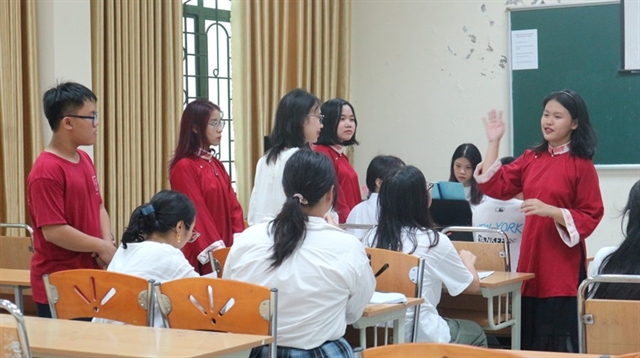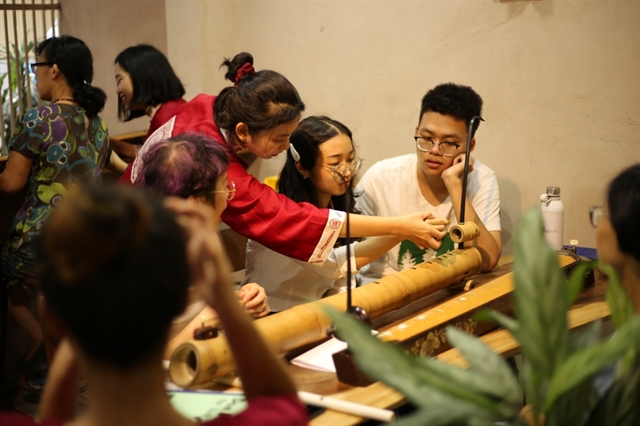 Sunday/Weekend
Sunday/Weekend

 |
| Cầm Ca Club members perform folk music on an out-door stage. The three-year-old traditional music club has taught hundreds of people how to play Vietnamese instruments for free. VNA/VNS Photos |
Thanh Hà
There is no doubt that pop, rock and hip-hop have been the favourite genres in Việt Nam's music industry for years. Their domination on TV channels, stages and social networks gives other types of music little chance to reach audiences, especially young ones.
Lê Hà Thu is one of several people who want to publicize Vietnamese traditional music to many people. She transfers her love of folk music and teaches them to play instruments that keep them interested.
This is how Cầm Ca, a traditional music club, and the free-of-charge Bình Dân Học Nhạc (Music Education for the Masses) Campaign was born.
Love for music
Thu grew up listening to the đàn bầu (monochord), and since she was seven, she has shown her special love for the typical Vietnamese musical instrument. As she grew up, the more she respected and wanted to promote the sweet and soulful sounds of traditional music.
"The instrument I love the most is the đàn bầu, which I have known since I was a little girl," she said.
"I guess my love for traditional music has been nurtured from those days, and I want more people to know about it and play with me."
 |
| Lê Hà Thu (right) is seen in a music class. Thu is the founder and president of the Cầm Ca Club. |
Near the end of her 11th grade in 2019, Thu decided to establish the Cầm Ca Club to deliver beautiful music that carries her national soul closer to her classmates, schoolmates and the wider community.
"Cầm" means musical instrument, and "Ca" means singing. Cầm Ca simply means playing music and singing songs. It was originally a music and singing club exclusively for students of the Hà Nội-Amsterdam High School, but now it has become a social club welcoming people of all ages and backgrounds.
The latest class has recently come to a close with great success.
Learners were first made familiar with the instruments, introduced to music theory, and taught to read music.
Moving to practice, they played and listened to their own music and classmates' to find their mistakes and correct them together.
A course is usually designed for four to eight classes based on which instrument was used and the schedule of teachers.
But this short time is enough for learners to deliver the first tune on the flute, zither and other instruments.
"The two-month course provided the most basic knowledge of music for learners. We want to make it the first step in helping our 'students' overcome their initial confusion and worries about traditional music," said Thu, a student of both the National Music Academy and the Water Conservancy University.
"After knowing a little, they will find out which instrument is their real love and then take more time to practise and play."
Traditional music
Participants were not only guided to play familiar and well-known folk melodies normally but also how to remix traditional songs by combining their flutes and zithers with beatbox rhythms and playing different genres of music with traditional instruments.
 |
| Learners can register for as many music classes as they want at the Cầm Ca Club. Teachers are dedicated and happy to teach with their hearts. |
A cover version of the music in the movie Mắt Biếc (Dreamy Eyes) and songs such as Quá Lâu (Quite a Long Time) and Chạy Về Khóc Với Anh (Cry with You) were performed by Cầm Ca and received great feedback and encouragement.
"My knowledge of music was zero before joining Cầm Ca. But now I understand better about Việt Nam's traditional music and instruments. It is quite different from what I imagined," said Trần Thanh Thúy, one of the learners.
"Here, I enjoy great experiments and experience with music and classmates as well as dedicated teachers. The more I learn, the more I am proud of our music culture."
Meanwhile, Lê Lan Hương, a grade 12 student, has been glued to the club since its first day. She says she has learnt much more about different instruments and how to play them after three years. She has also made many new friends who share her new passion.
Hùng Anh, a student of the Hà Nội University of Medicine and Pharmacy, said: "Taking part in the club, I have an opportunity to show my ability, my feeling and emotion while earning unforgettable experiences as an 'artist' after hard studying at the college. It is a great time for relaxation and entertainment. And it also opens the door to a new world of traditional music for me to develop."
Meanwhile, the club's teachers are all students from different colleges who regularly improve their profession with professional music teachers and artists to ensure the quality of their lessons at Cầm Ca's classes.
Teachers and learners are also encouraged to teach each other in a know-one-teach-one spirit to develop traditional music playing in the club and the community.
Club President Thu said: "Since its third year, Cầm Ca has worked with a classical music club of the Hà Nội Economics University, so that club's learners will have a chance to access other instruments such as guitar, piano and drum, which, when combined with traditional instruments in an orchestra, make amazing music.
 |
| Cầm Ca members are invited to many events to discuss their plan to popularise traditional music. They also have indoor and outdoor performances after class. |
Cầm Ca Club members have been invited to many cultural projects and events to perform and discuss their plans and dreams.
They have even set up their stage on pedestrian streets at the weekend to introduce the club, its programmes and amateur but enthusiastic members.
It is, according to Thu, also a way to draw people's attention to traditional music.
"I am happy because they open their hearts to our music and Vietnamese music. The audience's applause and members' smiles after each performance strongly push me to work harder on this mission," Thu said.
"I believe Cầm Ca is more than a club. It is home to passion, happiness and respected friends. VNS




